The first Ferrari did not bear that name, but was known at the AAC 815. The following car, and the first to be called a Ferrari, was the 125S, first seen in the spring of 1947. This was, however, destined for competition, and it was not until the Turin Motorshow of the following year that the first 'road' car was shown, the 166. These cars established the trend to name the car according to the swept volume of one cylinder, expressed in cubic centimeters, and was followed by the increasing capacity 195 and 212 models.
Ferrari 125
Debuting at the circuit of Piacenza in May 1947, this car used a tubular
steel chassis by Gilco and a V12 engine designed by Colombo. The suspension
used double whishbones and transverse leaf spring at the front and a rigid
axle with leaf springs at the rear. Telescopic dampers were used on all four
corners, as were light alloy hydraulically actuated brake drums.
The engine was a 1497cc 60° V12 with a compression ratio of 8.5:1 and a power
output of 100bhp @ 7,000rpm. It had twin overhead camshafts on each cylinder
bank and was fed by three double-choke Weber 30 DCF carburettors.
Ferrari 166
The 166 was also very successful in motorsport, winning the Mille Miglia in both 1948 and 1949, and the Giro d'Italia in the same years.
The Spa 24-hour race was also won in 1949 by a 166.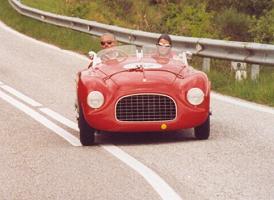 The Turin Motorshow of 1948 saw a new Ferrari revealed, with two bodysyles.
Both the barchetta MM and the coupe were by Touring, whilst the mechanicals were derived from the competition cars.
The suspension followed the design used in the 125 (detailed above) whilst the engine was still a 60° V12 but now with only
one camshaft per bank, a capacity of 1995cc and a power output of 115bhp @ 6,000rpm (in the Inter version). Various levels of tune were
available, such as a single carburettor or three, depending on the customers wishes.
The Turin Motorshow of 1948 saw a new Ferrari revealed, with two bodysyles.
Both the barchetta MM and the coupe were by Touring, whilst the mechanicals were derived from the competition cars.
The suspension followed the design used in the 125 (detailed above) whilst the engine was still a 60° V12 but now with only
one camshaft per bank, a capacity of 1995cc and a power output of 115bhp @ 6,000rpm (in the Inter version). Various levels of tune were
available, such as a single carburettor or three, depending on the customers wishes.
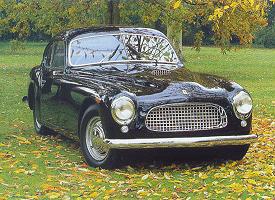 The cars were bodied by a variety of carrozzeria as both barchettas and coupes. Touring built several, but generally the chassis were supplied bare to the coachbuilder
of the customers choice, these including Stabilimenti Farina, Ghia and Vignale. A total of around 39 cars were built from 1948 until 1950.
The cars were bodied by a variety of carrozzeria as both barchettas and coupes. Touring built several, but generally the chassis were supplied bare to the coachbuilder
of the customers choice, these including Stabilimenti Farina, Ghia and Vignale. A total of around 39 cars were built from 1948 until 1950.
Ferrari 195
It is worth noting that a 195-engined 166 also won the 1950 Mille Miglia.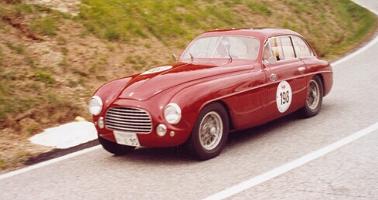 1951 saw a logical development of the 166 emerge at the Brussels Motorshow, namely the 195. Essentially the same car with a slightly
longer wheelbase and a new engine, it had a short life, since the 212 was released simultaneously. Only around 27 cars were built in the space of less than
a year before it was dropped from the lineup. Again a variety of coachbuilders provided the bodywork including Ghia, Touring, Ghia Aigle and Vignale.
1951 saw a logical development of the 166 emerge at the Brussels Motorshow, namely the 195. Essentially the same car with a slightly
longer wheelbase and a new engine, it had a short life, since the 212 was released simultaneously. Only around 27 cars were built in the space of less than
a year before it was dropped from the lineup. Again a variety of coachbuilders provided the bodywork including Ghia, Touring, Ghia Aigle and Vignale.
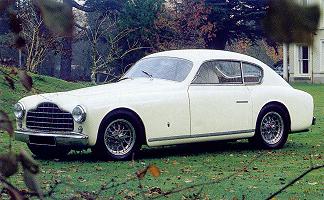 The engine was an increased bore version of the 166 unit with a total capacity of 2341cc. With a single Weber 36DCF carburettor it generated 135bhp @
6,000rpm, although a triple installation was also optional. The suspension layout continued unchanged from the earlier cars.
The engine was an increased bore version of the 166 unit with a total capacity of 2341cc. With a single Weber 36DCF carburettor it generated 135bhp @
6,000rpm, although a triple installation was also optional. The suspension layout continued unchanged from the earlier cars.
Ferrari 212
Following the already established route of gradual development, the 212, unveiled in 1951, was a further step on from the 195. Again the wheelbase was slightly stetched (in the 'Inter' version, the 'Export' had a shorter wheelbase), similarly the increase in capacity to 2562cc came from another increase in bore, now up to 68mm (up from 60mm in the original 166). In the more powerful 'Export' version (with three Weber 36DCF carburettors) the power went up to 165bhp @ 7,500rpm whilst in the 'Inter' (with one carburettor) it was 150bhp. In 1952 modified cylinder heads were adopted which liberated about an extra 5bhp. The brakes and suspension of the 212 retained the same layout as the earlier cars, whilst the same carrozzeria (Touring, Vignale and Ghia) also provided the bodies - with one important new addition, that of Pinin Farina. A total of around 80 examples were completed.
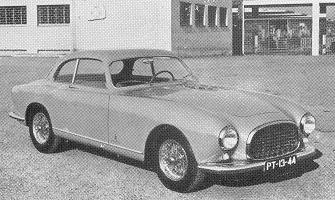 |
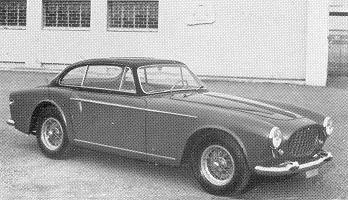 |
See our picture gallery index for images from museums, motorshows and events.
There are also wallpapers/desktop backgrounds available to download.
Use the buttons at the top to navigate
further, or
Copyright © 2000 to 2011 CarsfromItaly